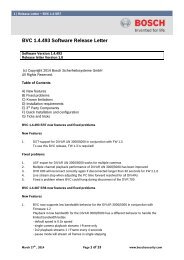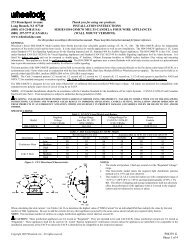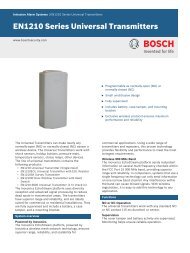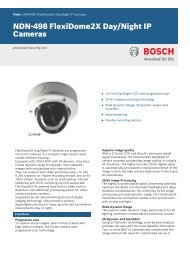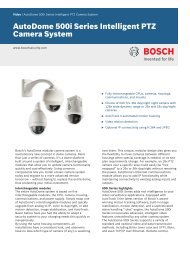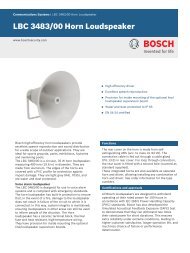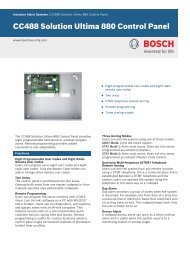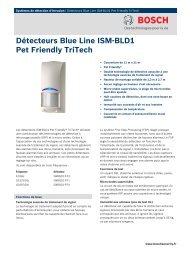VRM Video Recording Manager - Bosch Security Systems
VRM Video Recording Manager - Bosch Security Systems
VRM Video Recording Manager - Bosch Security Systems
You also want an ePaper? Increase the reach of your titles
YUMPU automatically turns print PDFs into web optimized ePapers that Google loves.
28 en | User interface <strong>VRM</strong> <strong>Video</strong> <strong>Recording</strong> <strong>Manager</strong><br />
CAUTION!<br />
Alarm tracks must be set up in the partition for alarm recording.<br />
The encoder uses a special recording mode during alarm recording for optimal usage of<br />
storage capacity: as soon as a time gap for alarm recording begins, a recording is continuously<br />
made on one segment, which is the size of a complete alarm sequence (pre- and post-alarm<br />
time).<br />
This segment in the partition works like a ring buffer and is overwritten until an alarm is<br />
actually triggered. <strong>Recording</strong> occurs on the segment only for the duration of the preset postalarm<br />
time and a new segment subsequently used in the same way.<br />
Click to get step-by-step instructions:<br />
– Section 7.8.2 Configuring alarm tracks (firmware up to 3.5x), page 15<br />
11.11 <strong>Recording</strong> Preferences tab<br />
Main window > Devices tab > Expand > Expand Devices > > <strong>Recording</strong> ><br />
<strong>Recording</strong> Preferences tab<br />
The <strong>Recording</strong> preferences page is displayed for each encoder. This page only appears if a<br />
device is assigned to a <strong>VRM</strong> system.<br />
Note: When you configure the automatic recording mode, you cannot configure any settings<br />
here.<br />
Section 11.3 <strong>VRM</strong> Settings tab, page 21<br />
Mode<br />
Select the required option.<br />
– All<br />
The <strong>VRM</strong> system discovers all available and configured iSCSI targets and assigns the<br />
available capacity automatically. If a target fails or memory capacity is used, another<br />
target is selected automatically. In this case, you cannot enter targets on the tab.<br />
– Restricted<br />
<strong>Recording</strong>s are stored primarily to the targets entered here. Primary target and<br />
secondary target are used equivalently.<br />
If no disk space is available on either of the targets entered, other storage blocks of the<br />
<strong>VRM</strong> system are used until there is space available again on the entered targets.<br />
– Failover<br />
<strong>Recording</strong>s are saved only to primary target. If it is not possible to save to this target, the<br />
recording will be saved to the target entered under secondary target.<br />
A failure situation is reached if the primary target does not provide storage blocks due to<br />
whatever reason: system down, network error, no capacity left.<br />
You can leave the second list empty. In this case no failover is possible but the number of<br />
required iSCSI sessions is reduced.<br />
– Preferred<br />
<strong>Recording</strong>s are saved to the entered targets in the specified sequence. For this, enter<br />
both a primary and a secondary target. The secondary target is only used while the<br />
primary target has no storage capacity available.<br />
Only if these targets are not available, the recordings will be distributed across other<br />
targets.<br />
DOC | V.2.21 | 2011.12 Operator's Manual <strong>Bosch</strong> Sicherheitssysteme GmbH



